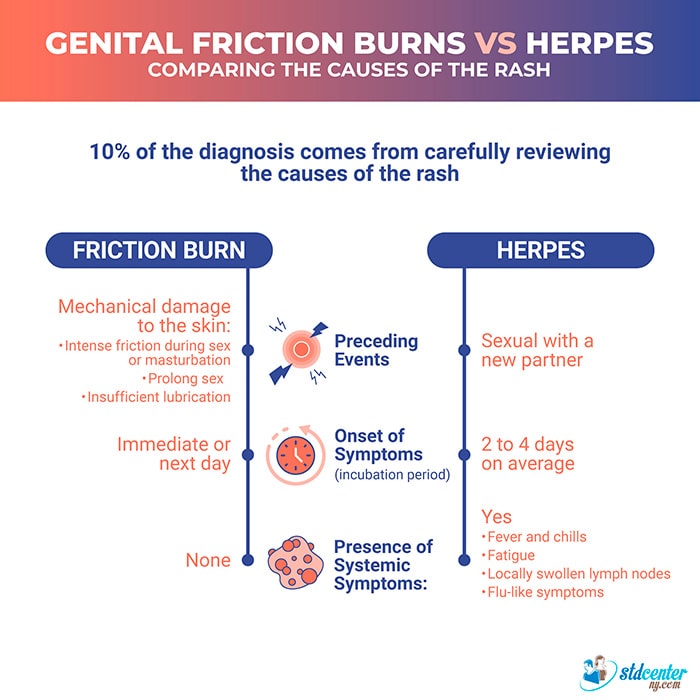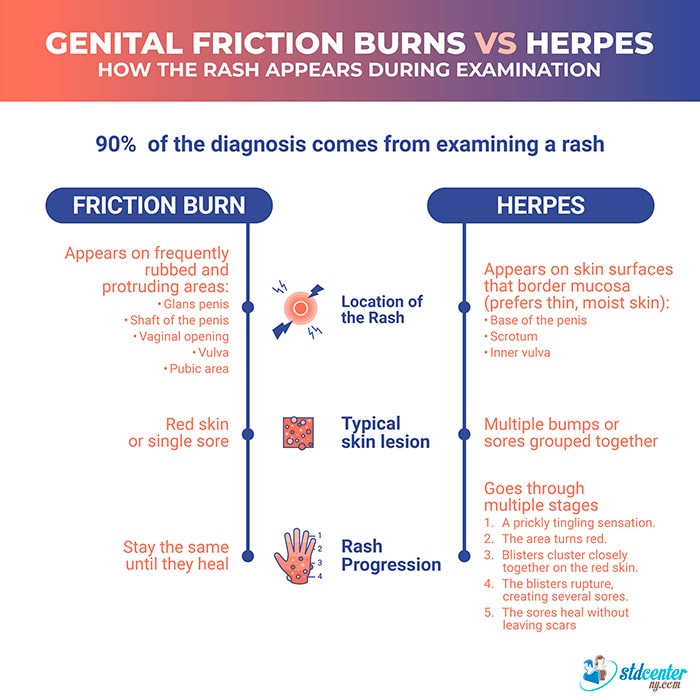“History” of the Rash or Understanding Rash Causes
Ten percent of the diagnosis comes from establishing the causes of the rash.
Here are the three key areas that should be thoroughly reviewed:
1. Preceding Events:
- - Herpes:The rash usually develops after sexual contact with a new partner. [4] Herpes Genitalis: Diagnosis, Treatment and Prevention https://pmc.ncbi.nlm.nih.gov/articles/PMC5177552/
- - Friction Burn: This type of rash results from mechanical damage to the skin, which can occur due to [1] Friction burn https://my.clevelandclinic.org/health/diseases/friction-burn :
o Intense skin friction during sexual activity or masturbation
o Prolonged sexual activity
o Insufficient lubrication during these actions
2. Onset of Symptoms:
The incubation period is crucial for differentiating between herpes and friction burn:
- - Herpes: Symptoms typically emerge within 1 to 21 days after exposure, with an average of 2 to 4 days.
- - Friction burn: Symptoms such as a severe burning sensation on the skin usually arise immediately after the triggering event or the following day. [2] Friction Burns: Epidemiology and Prevention https://pmc.ncbi.nlm.nih.gov/articles/PMC3188131/
3. Presence of Systemic Symptoms:
The existence of prodromal symptoms can help in differentiation:
- - Herpes: Before the rash appears, systemic symptoms like fever, swollen lymph nodes, fatigue, and flu-like symptoms often occur. [3] Overview: Genital herpes https://www.ncbi.nlm.nih.gov/books/NBK525769/
- - Friction Burn: No systemic symptoms precede the rash's onset.
[1, 2]
Friction burn
https://my.clevelandclinic.org/health/diseases/friction-burn
Friction Burns: Epidemiology and Prevention
https://pmc.ncbi.nlm.nih.gov/articles/PMC3188131/


How the Rash Appears During Examination
Ninety percent of the diagnosis comes from examining a rash.
1. The location of the rash 2. The appearance and progression of the rash.
1. Location of the Rash
Friction burns, and herpes can affect the same general area but impact different parts. Herpes lesions typically appear on skin surfaces that border mucosa, as the herpes virus prefers thin, moist skin. These areas include:
- - Base of the penis
- - Scrotum
- - Inner vulva
In contrast, friction burns can occur in any frequently rubbed area, usually on protruding or commonly used surfaces, regardless of skin thickness. Affected areas include:
- - Glans penis
- - Shaft of the penis
- - Vaginal opening
- - Vulva
- - Pubic area
2. Rash Appearance and Progression
Friction burn rashes stay the same until they heal, unlike herpes rashes that change over time [1] Friction burn https://my.clevelandclinic.org/health/diseases/friction-burn .
Herpes rashes progress through these stages [4] Herpes Genitalis: Diagnosis, Treatment and Prevention https://pmc.ncbi.nlm.nih.gov/articles/PMC5177552/ :
- 1. A prickly tingling sensation.
- 2. The area turns red.
- 3. Blisters cluster closely together on the red skin.
- 4. The blisters rupture, creating several sores.
- 5. The sores heal without leaving scars.
On the other hand, friction burns cause the skin to turn red and result in a single sore, in contrast to the multiple sores associated with Herpes [3] Overview: Genital herpes https://www.ncbi.nlm.nih.gov/books/NBK525769/ . They typically swell slightly and heal within about a week without leaving scars.
Unlike friction burns, friction blisters are rare in areas with thin skin, such as the penile shaft and scrotum or vagina.


Source
-
Friction burn
https://my.clevelandclinic.org/health/diseases/friction-burn -
Friction Burns: Epidemiology and Prevention
https://pmc.ncbi.nlm.nih.gov/articles/PMC3188131/ -
Overview: Genital herpes
https://www.ncbi.nlm.nih.gov/books/NBK525769/ -
Herpes Genitalis: Diagnosis, Treatment and Prevention
https://pmc.ncbi.nlm.nih.gov/articles/PMC5177552/